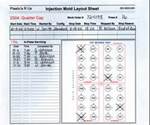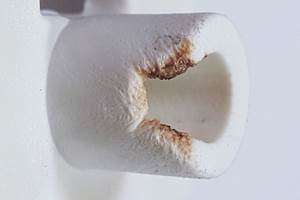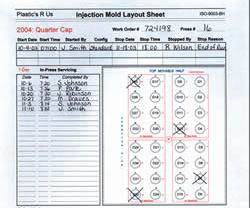Creating a Mold-Repair Plan-Part II: The Last Shot Inspection Report
Last month, we discussed how to collect accurate mold performance data at the press through the use of an IML (injection mold layout) sheet.
Last month, we discussed how to collect accurate mold performance data at the press through the use of an IML (injection mold layout) sheet. We will now begin to consolidate the IML, Last Shot inspection, and records of past maintenance issues to create our repair plan.
‘Putting out fires’ is not a plan
For some molding companies, creating a mold-repair plan usually means setting a mold on a repair technician’s bench with instructions such as, “Mold flashing. Fix it.” Other firms might have a log or notebook for each mold, which the technician must decipher and then decide what to fix. Without a repair plan, critical downtime hours will be wasted determining exactly what to do.
A systematic approach to creating a repair plan is based on the idea of breaking down performance and maintenance information into categorized mold “events.” These include specific descriptions of mold and part defects, probable causes, corrective actions, and preventive actions. Developing and maintaining this information requires professional discipline and strict procedures that are foreign to many mold-maintenance shops in the U.S. This is one area in which we need to change our “firefighting” corporate culture to improve our stance against foreign competition.
Last Shot sheet is the key
When the tool room receives the IML and Last Shot samples from the molding department, the first priority must be to examine the Last Shot samples for hidden part-quality issues. The Last Shot is an important key to accurate mold repair. Unfortunately, many QA/QC departments are not required to document parts that are close to specification limits, only those that are over the limits. The Last Shot may also contain defective parts that either slip by QA or that became defect issues after the last QA check, just before the mold was shut down and pulled for maintenance.
There are no painless ways to get this critical information included on the repair plan. Someone from QA, metrology, molding, or the tool room must inspect the Last Shot for the following issues:
- Measure all flash lengths.
- Flag any flash over half the maximum allowable amount.
- Note any areas where mold finish is close to non-conforming.
Many mold shops disregard the Last Shot sheet because there is no formal policy in place that designates who is responsible for collecting and recording this data. It is less confrontational to assume—incorrectly—that the Last Shot report holds no relevant mold-maintenance information worth the time it takes to collect and inspect the shot. But for the toolroom technician, there is no better indicator of the overall health of a mold than examining the Last Shot report on a mold that was running in a consistent process.
To repair or not to repair?
It is not uncommon for a multicavity mold coming off a 400,000-cycle run to have several cavities close to the maximum allowable flash limit show up in the Last Shot samples. Choosing whether to repair these defects will be based on careful consideration of the available repair time, available replacement tooling parts, and historical data (past Last Shot measurements) on flash.
Occasionally, we will choose not to implement corrective action for a part with nominal flash. By continuing to monitor the part, repair technicians will improve their ability to forecast tooling life by observing the relationship between worn tooling and growing flash length. Continuous comparison of flash to tooling wear under magnification is valuable experience that will allow repair technicians to maximize tool life by making better decisions.
Such observation also is a good test of the stability of a molding process. If 0.020-in. flash is here one day and either gone or doubled in length the next, with no corrective action performed by the tool room, it begs the question, “What else has changed?”
Once the Last Shot has been inspected, a determination is made as to what defects will be corrected. The accompanying sample report demonstrates what information a Last Shot Inspection Sheet should contain. This information is then incorporated into the instructions on the repair sheet.
In Part III, the mold-repair plan comes together.
Steven Johnson worked as a toolmaker for 26 years, rebuilding and repairing multicavity molds for Calmar Inc. and then as mold-maintenance engineer for Hospira Inc., a medical device manufacturer. Today, he is the maintenance systems manager for Progressive Components and has his own business, MoldTrax in Ashland, Ohio, which designs and sells software for managing mold maintenance (www.moldtrax.com). He can be reached at steve@moldtrax.com or (419) 289-0281.
Related Content
Best Methods of Molding Undercuts
Producing plastics parts with undercuts presents distinct challenges for molders.
Read MoreHow to Optimize Pack & Hold Times for Hot-Runner & Valve-Gated Molds
Applying a scientific method to what is typically a trial-and-error process. Part 2 of 2.
Read MoreBack to Basics on Mold Venting (Part 1)
Here’s what you need to know to improve the quality of your parts and to protect your molds.
Read MoreHow to Select the Right Tool Steel for Mold Cavities
With cavity steel or alloy selection there are many variables that can dictate the best option.
Read MoreRead Next
Creating a Mold-Repair Plan-Part I: The Mold Layout Sheet
Regardless of mold type, the goal of the maintenance shop always is the same: Get a mold production-ready after it has been removed from service.
Read MoreAdvanced Recycling: Beyond Pyrolysis
Consumer-product brand owners increasingly see advanced chemical recycling as a necessary complement to mechanical recycling if they are to meet ambitious goals for a circular economy in the next decade. Dozens of technology providers are developing new technologies to overcome the limitations of existing pyrolysis methods and to commercialize various alternative approaches to chemical recycling of plastics.
Read MorePeople 4.0 – How to Get Buy-In from Your Staff for Industry 4.0 Systems
Implementing a production monitoring system as the foundation of a ‘smart factory’ is about integrating people with new technology as much as it is about integrating machines and computers. Here are tips from a company that has gone through the process.
Read More

























